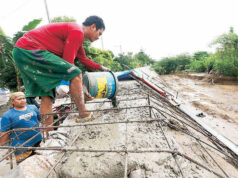PPP: Public-Private (Parking) Partnership
About a couple of years ago, a big parking lot was put up at the corner of Yakal St. and Chino Roces Ave. in Brgy. San Antonio, Makati City. At the start, very few cars could be seen parked there. But now, it is usually full. The lot appears privately owned, and the parking privately managed. But the benefit is to the public, particularly the San Antonio community.
The parking facility was opened before one-side street parking was implemented in San Antonio. In short, even before the new parking regulation came in, there was already a facility available to those who might be affected. The lot now hosts not only the cars of residents but also delivery trucks of local businesses and even commuter jeepneys.
While the pay-parking lot, despite its size, is still not big enough to service all San Antonio residents, it was a good start, I believe. So, imagine if every Metro Manila barangay can find the means to put up a public parking facility for its residents? Barangays can get extra income from parking fees — and better manage on-street pay parking — while partly addressing congestion.
Of course, there are very few wealthy barangays that can actually afford to put up a parking facility for residents. And land is now very expensive anywhere in Metro Manila. An option is to look for suitable government land, or properties owned by the national government or government-owned and -controlled corporations. Or, land to be auctioned because of unpaid real estate taxes.
Municipal or city parking is one area where, I believe, the PPP or Public-Private Partnership can work well. Local governments can make land available to private parties through build-operate arrangements. Multi-level parking is ideal, possibly with some commercial and office spaces for rent. While the city can collect parking fees, the proponent earns from the rentals. The city retains land ownership. The PPP arrangement can be for 25-50 years.
I am certain that development institutions like the World Bank and the Asian Development Bank will also be interested in financing such projects. An option is for the city to issue bonds to investors to raise money to buy land, while a private proponent comes in to build the parking facility. Both city and proponent earn from parking and rental, and repay bond investors.
In many places in Metro Manila now, we need parking as much as we need roads, for the simple reason that part of our roads is used for parking. I still believe that efficient public transportation is the answer. If efficient, convenient, and affordable public transportation is available, why will people bother to take cars? For now, however, more parking will help clear more roads.
GSIS, for instance, owns a huge tract of land at the Quezon Memorial Circle, just off Commonwealth Avenue. For decades, that property has been practically vacant. GSIS also owns a building in Legaspi Village in Makati. Landbank, I believe, owns a vacant building on Buendia/Gil Puyat Avenue. Then, there is the old NEDA building on Amorsolo.
The government has also assumed control over the entire strip that includes Sunvar Plaza, Mile Long, and Creek Side also on Amorsolo St. in Makati. There is talk that the property is now being prepped for development by private parties, and that Makati City is being convinced to put up a subway station in the area. If so, then this makes the property suited for multi-level parking as well.
The World Bank’s Public-Private Partnership Legal Resource Center (WBPPPLRC) lists a number of PPP projects that involved parking facilities. In Australia, for example, it noted that a Build, Own, Operate and Transfer (BOOT) agreement was signed for a car park at a public hospital. PPP was also used for a parking concession for Light-Weight Vehicles in the Tabo Commune in Valparaiso, Chile.

The WBPPPLRC also said that in Bhutan, in Thimphu City, a PPP agreement was signed for the development and management of an integrated parking system that will include two new multi-level car parks with at least 550 parking spaces as well as the upgrading and management of about 1,000 off-street and on-street surface parking in the city. This is to be done through a design, build, finance, operate and transfer concession (DBFOT).
And then in Santiago, Chile, a concession was granted for the operation of Parking Meters on Public Roads of Providence Commune. The concession is for the provision, maintenance, functioning, and use of the parking meter system on public roads. The eight-year contract was awarded based on highest per transaction payment to the municipality. Also, penalties were set for non-performance or not meeting service standards.
In Bogota, Colombia, a concession agreement was also signed between the City of Bogota’s Urban Development Institute and Union Temporal City Parking, a private entity. This is for the maintenance, administration, and operation of the Public Parking Facilities owned by the Urban Development Institute (a municipal public entity for the City of Bogota).
The two-year agreement is renewable by mutual accord. The contract does not commit the public sector to minimum revenue payments. It contemplates fixed and variable payments from the private to the public entity, reviewed annually to keep with inflation. Maximum tariffs (parking fees) are set by decree. There are minimum service requirements and duties outlined in the contract and its bases; however, the contract is not a performance-based or results-based agreement. But there are penalties for non-performance.
In Uttar Pradesh, India and in Nairobi, Kenya, concession agreements were drafted for the construction and operation of multi-level car parks. And in Vilnius, Lithuania, the agreement was for the concessionaire to finance renovations, purchase new land and property, operate the car park, and transfer it on expiry of the concession.
In Peru, the Municipality of Miraflores established a public-private partnership with a private consortium for the construction of a 573-slot underground parking lot, with a projected private investment of approximately $9 million, to be completed in a year. The public sector invested in the studies and offered the real estate.
Also, in Peru, in San Borja, the was a public-private partnership for the construction and operation of a 350-slot Underground Parking facility. The public-private partnership was for the design, financing, construction, operation, maintenance, and transfer of 14,320 square meters of space, including an underground parking lot and commercial space at ground level.
The period of the contract is 32 years from the date of signing. The municipality will receive 8% of income from the parking operations and rental income from commercial space. The private party is free to set prices on both the parking and rental operations. The contract provides for rebalancing of economic and financial terms due to changes in law.
There are many ways that local government, private companies, and development institutions can work together on municipal parking projects. I am sure we have many other examples locally where state and citizens came together to address development issues. Parking is a problem in all urban areas. It is about time we get more creative with our solutions.
Marvin Tort is a former managing editor of BusinessWorld, and a former chairman of the Philippines Press Council.



